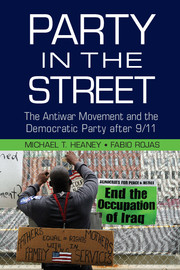Book contents
- Frontmatter
- Dedication
- Contents
- List of Tables
- List of Figures
- List of Abbreviations
- Introduction
- 1 The Party in the Street and Its Historical Context
- 2 Partisan Politics at the Water's Edge?
- 3 Multiple Identities and Party-Movement Interaction
- 4 Identities and Grassroots Participation
- 5 Identities and Organizational Action
- 6 Identities and Legislative Agendas
- 7 Beyond the Antiwar Movement and the Democratic Party
- 8 Social Movements in a Polarized America
- Epilogue
- Appendixes
- References
- Index
6 - Identities and Legislative Agendas
Published online by Cambridge University Press: 05 February 2015
- Frontmatter
- Dedication
- Contents
- List of Tables
- List of Figures
- List of Abbreviations
- Introduction
- 1 The Party in the Street and Its Historical Context
- 2 Partisan Politics at the Water's Edge?
- 3 Multiple Identities and Party-Movement Interaction
- 4 Identities and Grassroots Participation
- 5 Identities and Organizational Action
- 6 Identities and Legislative Agendas
- 7 Beyond the Antiwar Movement and the Democratic Party
- 8 Social Movements in a Polarized America
- Epilogue
- Appendixes
- References
- Index
Summary
Iraq is like many issues that progressives work on in the sense that you have a lot of organizations outside of Congress that are trying to change US policy. So, part of the challenge, frankly, is to connect like-minded members in Congress with the growing opposition around the country.… It requires, first of all, getting the progressives inside Congress better organized to advance their agenda and, equally important, that has to be organically connected to the movement outside of Congress.… We follow what we call the “inside-outside strategy,” which guides us in efficiently organizing against Bush's policy inside Congress. Then, we link up with whatever coalitions exist outside of Congress.
Bill Goold, executive director of the Congressional Progressive Caucus (Goold 2008)A fundamental question for the party in the street is how to connect with other parts of the party, especially the party in government. One strategy that its adherents use – as Bill Goold explains in the opening quote – is to simultaneously work inside and outside political institutions, such as Congress. Their objective is to use the power of those institutions to accomplish some of the goals of the movement (Weldon 2011). These efforts are facilitated by a handful of leaders who are both a part of the party in the street and the party in government. Members of Congress who regularly speak at movement rallies and conferences – such as Representative John Conyers Jr., pictured in Figure 6.1 in front of a banner reading “Healthcare Not Warfare” – might be counted as belonging to this group. For the antiwar movement after 9/11, we also think of Representatives Dennis Kucinich, Barbara Lee, Jim McGovern, Maxine Waters, and Lynn Woolsey as having filled this niche. Other members of Congress may straddle the fuzzy boundary (which we describe in Chapter 1) between the party in the street and the mainstream political party. Yet the vast majority of members of Congress do not fully embrace the sentiments of the party in the street, even if they do sympathize with some of its goals. A significant challenge for the movement is to recruit these potential supporters to promote the movement's agenda.
- Type
- Chapter
- Information
- Party in the StreetThe Antiwar Movement and the Democratic Party after 9/11, pp. 173 - 204Publisher: Cambridge University PressPrint publication year: 2015

